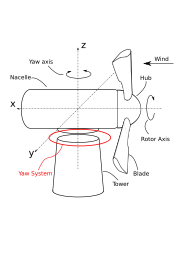Yaw drive

The yaw drive is an important component of the horizontal axis
cosine
of the yaw error).
History
When the
windmills
used ropes or chains extending from the nacelle to the ground in order to allow the rotation of the nacelle by means of human or animal power.
Another historical innovation was the
gearbox (and via a gear-rim-to-pinion mesh) to the tower of the windmill. The effect of the aforementioned transmission was the rotation of the nacelle towards the direction of the wind, where the fantail would not face the wind thus stop turning (i.e. the nacelle would stop to its new position).[1]
The modern yaw drives, even though electronically controlled and equipped with large
electric motors and planetary gearboxes have great similarities to the old windmill
concept.
Types
The main categories of yaw drives are:
- The Electric Yaw Drives: Commonly used in almost all modern turbines.
- The Hydraulic Yaw Drive: Hardly ever used anymore on modern wind turbines.
Components

Gearbox
The
gearboxes have input to output ratios in the range of 2000:1 in order to produce the enormous turning moments required for the rotation of the wind turbine nacelle
.
Gear rim and pinions
pinions
.The gear-rim and the
pinions of the yaw drives are the components that finally transmit the turning moment from the yaw drives to the tower in order to turn the nacelle of the wind turbine around the tower axis (z axis). The main characteristics of the gear-rim are its big diameter (often larger than 2 m) and the orientation of its teeth
.
The gear-rims with
.See also
References
- ISBN 3-934595-23-5
Further reading
- Wind Power Plants, R. Gasch and J. Twele, Solarpraxis, ISBN 3-934595-23-5
- Wind Energy Handbook, T. Burton [et al.], John Wiley & Sons, Ltd, ISBN 0-471-48997-2
